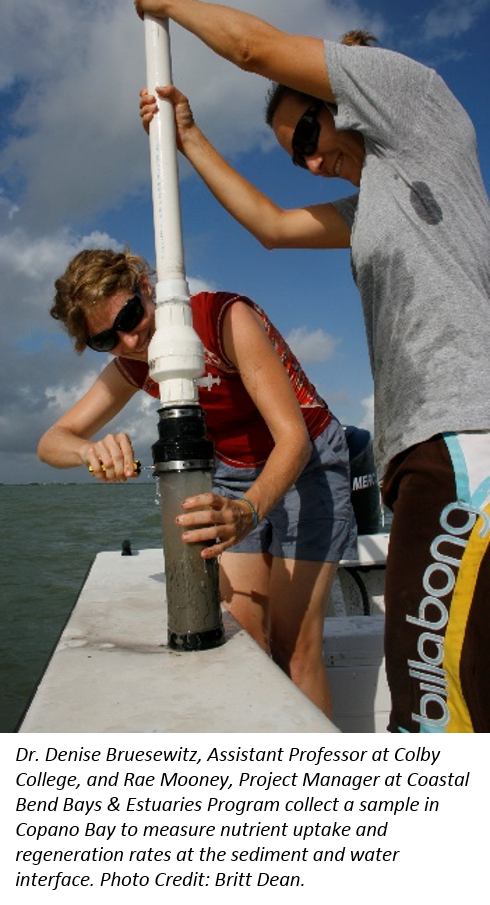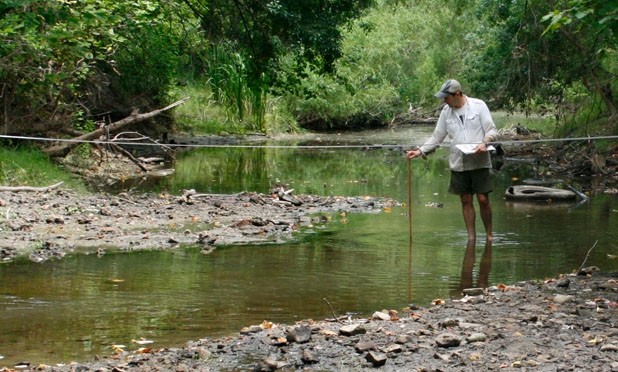A new study finds that river systems can remediate the effects of wastewater influences during droughts.  A team of chemists and biologists studied two South Texas rivers to understand how droughts change the nutrients in the rivers and the estuaries they flow into.
A team of chemists and biologists studied two South Texas rivers to understand how droughts change the nutrients in the rivers and the estuaries they flow into.
The researchers took advantage of two un-obstructed rivers in South Texas, the Mission and Aransas rivers, which are geologically similar, but have differences in how humans use those rivers. The Mission River originates in Refugio, Texas, is affected little by humans while the Aransas River receives wastewater treatment plant effluent from the town of Skidmore, Texas. During a drought, wastewater effluent is the primary source of nutrients used by plants within the rivers and estuaries.
The researchers studied the effect of droughts on the nutrient concentrations of these two rivers and changes of how the nutrients are used within the rivers. Droughts are a dominant phenomenon in Texas and cause less freshwater transport to estuaries, and deliver less nutrients from rain and runoff. Estuaries act as the nurseries of the sea and shelter many of the commercial and recreational fisheries such as blue crabs, red drum and spotted sea trout. Dr. Denise Bruesewitz of Colby College and her colleagues from The University of Texas Marine Science Institute, Coastal Bend Bays & Estuaries Program, and Loyola University Chicago were interested in the nutrients available to these nurseries during a drought and how wastewater impacted their availability.
To answer this question is challenging because nutrient measurements are linked to ecosystem characteristics, such as how fast the water is flowing, which means that researchers have to use different methods to measure them in fresher, faster flowing rivers than in slower moving estuaries. “Science tends to pigeonhole processes that occur in rivers and the ocean,” said Dr. Ed Buskey, co-author and professor at The University of Texas Marine Science Institute. “Research like our study is rare because trying to understand the connection between the two can be difficult because where the rivers meet the estuaries is a dynamic environment that is constantly changing.”
While working in two different systems is challenging, finding drought in South Texas isn’t. Surprisingly, the researchers found that during a drought, the Aransas River with more nutrients coming from wastewater effluent did not continue to transport those nutrients down to the estuary. During drought periods, the river moves slower, which gives the microscopic plants called phytoplankton and other organisms in the rivers more time to absorb and use up the nutrients.
Conversely, the rivers move big pulses of the nutrients during large rain events. When this happens, most of the primary nutrient nitrogen is gobbled up by microbes which turn it into nitrogen gas that goes into the air and leaves the river before reaching the estuary. This study showed that during a drought, the system flips and special nitrogen-fixing bacteria in the rivers and estuaries convert nitrogen from the air into ammonia, which is easy for phytoplankton to absorb. “The system can self-correct itself to a certain extent without going too far out of whack,” Buskey said.
This research provides insight into how rivers move and change nutrients during periods of prolonged drought. This study gives water resource managers more information about how nutrients evolve and can change under different climate trends.
Along with Bruesewitz and Buskey, researchers Timothy Hoellein from Loyola University Chicago, Wayne Gardner from The University of Texas Marine Science Institute, and Rae Mooney from Coastal Bend Bays & Estuaries Program assisted with the findings.
This research was supported by the National Oceanic and Atmospheric Administration’s National Estuarine Research Reserve System and by the United States Environmental Protection Agency’s Gulf of Mexico Program.









